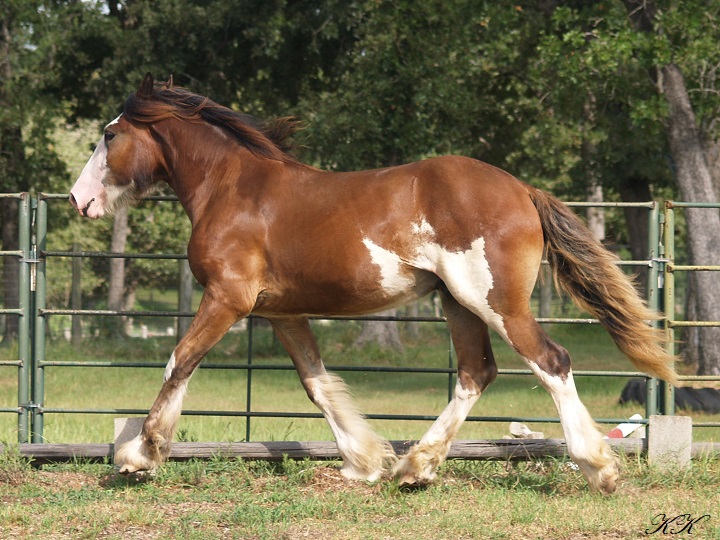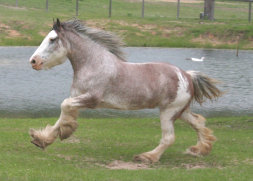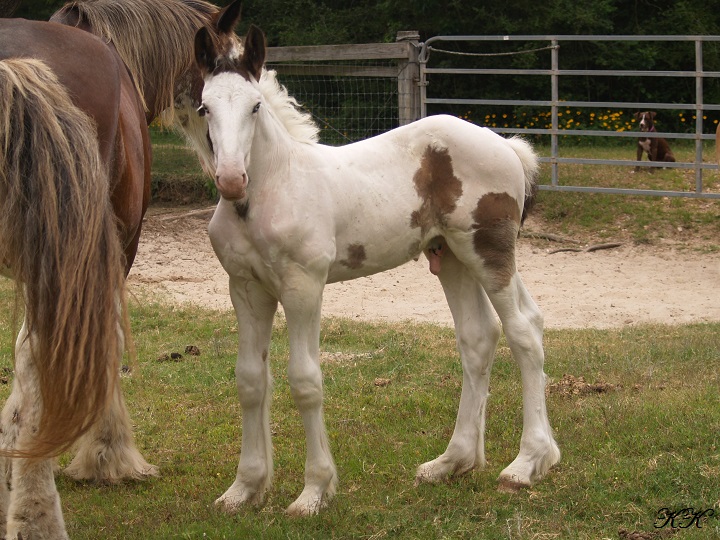Color Series Part 1: Tobiano vs Sabino
Written by Kelsey Kempton
Published September 2015; Updated January 2019
There are two pinto patterns seen in Drum horses. Tobiano, which is inherited through the gypsy bloodlines, and sabino, which can be inherited from any of the three foundation breeds. Tobiano and sabino have very different visual appearances and are easy to identify if you know what characteristics to look for. However, both patterns can appear on the same horse, which can make distinction a bit more difficult. So how can you tell if your horse is tobiano, sabino, or a mixture of both? Knowing the visual characteristics and the basic genetics of each pattern will give you a pretty accurate idea of your horses color. Tobiano is the most common pinto pattern. Tobianos typically have white legs and colored heads with some sort of facial marking. The white patches on tobianos have a vertical orientation with sharp, clean edges and usually cross the topline. The amount of white can vary from minimal, usually seen as white legs and perhaps one white body spot, to maximal, which is commonly known as a “medicine hat” with white covering a majority of the body except for the ears and possibly the chest. The tobiano pattern is dominant, meaning that only one copy of the gene is needed for expression of the tobiano pattern. There is no definitive visual difference between homozygotes and heterozygotes, but it has been documented that “ink spots,” which are smaller colored spots within areas of white, are more commonly seen on homozygous individuals than heterozygous. The only way to know for sure if your horse is homozygous or heterozygous is to get a genetic test. The sabino pattern is a bit more difficult to identify in some forms, and is far more difficult to understand genetically. Sabinos have white markings that progress from the legs up, rarely crossing the topline. They typically have white legs and large white facial markings. Belly spots are common as well. The edges of the white patches are irregular and some degree of roaning may also be seen. Note that “roaning” seen in sabino patterned horses is not the same as the genetic roan pattern. While they look similar, they are caused by completely different genes. The amount of white seen on sabinos is incredibly variable, which can make some sabinos difficult to identify. Some may be limited to white stockings and a blaze and can be mistaken as solid, but if the edges of the white stockings are irregular, the horse is likely sabino. Other sabino horses are entirely white and mistaken as genetic white. There is 0% incidence of genetic white in the foundation breeds, so if your Drum appears white, they are most likely sabino. The genetic cause of sabino is not yet fully known. What we do know is that sabino is polygenic, meaning that there is more than one gene controlling the sabino coat color. One variation of sabino is caused by the Sabino-1 gene, out of the foundation breeds this is only seen in Gypsies and is relatively uncommon. This variation is incompletely dominant, meaning that heterozygotes have typical sabino markings and homozygotes are completely or nearly completely white. Another variation of the sabino coloring is caused by the Dominant White complex. There are many different alleles of Dominant White, the only one identified in Gypsies, Clydesdales, and Shires is W20. W20 is the most common cause of sabino and “roaning” coloration in Drums, Clydesdales, and Shires. The Dominant White gene is dominant, but incredibly variable, so horses only need one copy of the gene to express the color, but expression can range from stockings and a blaze, to full body roaning. Homozygotes typically display a higher degree of white marking and roaning than heterozygotes. There are genetic tests for both Sabino-1 and Dominant White. Horses can express both tobiano and sabino at the same time. We classify horses carrying both of these patterns together as tobiano, since they more closely resemble tobianos with their large white patches that typically cross the topline. The easiest way to determine if your tobiano is also sabino is to look at the edges of the white patches. Tobianos have sharp, clean edges; a tobiano that also carries sabino will have irregular edges. They also tend to have larger white facial markings and some degree of roaning. Remember that all pinto genes are incredibly variable and your horse may not have all the visual identifiers of the genes they possess.Photos
Click on a photo to view a larger version.

Xena, an F2 Drum mare, exhibits the tobiano pattern. Note how the white patches cross her topline and have smooth edges. She also has minimal white markings on her face. She is heterozygous for tobiano.

Archie, an F2 Drum gelding, exhibits a minimal sabino pattern. Note how his body is mostly solid, but he has irregular edges on his stockings and a large white marking on his face. He is heterozygous W20.

Laureli, a Clydesdale mare, exhibits a max sabino pattern. Note the high stockings and large white facial marking, and the high degree of roaning. She is homozygous W20.

Kronos, an F3 Drum colt, exhibits both tobiano and sabino patterns. Note the irregular edges of his white patches and his large white facial marking. He is heterozygous for both tobiano and W20.